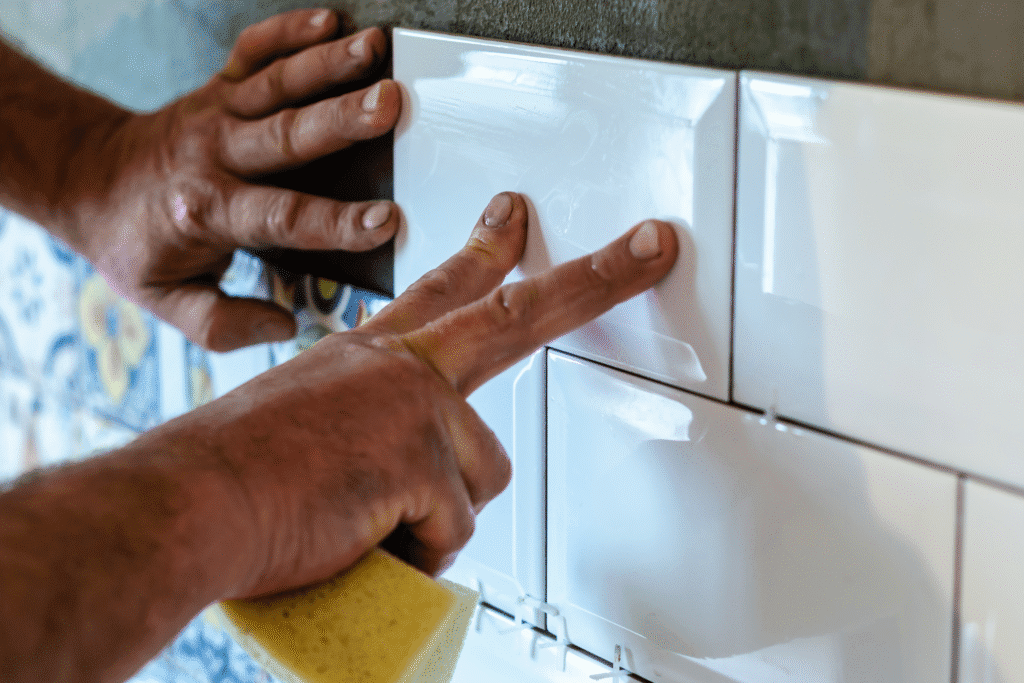
What is grout joint spacing and why does it matter?
Grout joint spacing defines the gap between tiles. It impacts tile durability, layout alignment, and long-term surface integrity. In Dubai’s humid climate, precise spacing also prevents moisture penetration and tile shifting due to thermal expansion.
Key impacts of grout spacing:
- Controls tile alignment accuracy
- Absorbs natural tile movement and expansion
- Enhances surface water resistance
- Prevents tile edge chipping
Porcelain tiles need joints of 2mm–3mm. Natural stone often requires 3mm+. Wider grout lines allow better flexibility in high-traffic Dubai areas like malls, villas, and outdoor terraces.
How does improper grout spacing cause tile failure?
Incorrect grout gaps lead to:
- Uneven tile layout
- Cracked grout lines
- Water seepage beneath tiles
- Lippage (height differences between tiles)
In Downtown Dubai apartments, narrow joints without spacers often crack due to building movement and air conditioning humidity. Correct spacing paired with flexible grout improves surface longevity.
What are the standard grout joint sizes by tile type?
| Tile Material | Recommended Grout Joint | Reason |
|---|---|---|
| Ceramic | 2–3mm | Allows slight manufacturing size variance |
| Porcelain | 2mm | Uniform edges allow tighter joints |
| Marble | 3mm+ | Prevents chipping on soft edges |
| Travertine | 3–5mm | Accommodates rough, varied surfaces |
Tip: For large-format tiles (e.g., 60×60 cm+), use at least 3mm spacing to absorb expansion and reduce cracking.
What tools ensure consistent grout spacing?
To maintain uniform joints, tile installers in Dubai use:
- Tile spacers: 1mm to 5mm; reusable and precise
- Laser levels: Keep tile rows aligned
- Grout floats: Ensure even grout application without overfilling
Professional tile layers always check local codes and manufacturer instructions. In Dubai, commercial spaces must follow DCD (Dubai Civil Defence) safety compliance for flooring and moisture control.
What is the best grout for Dubai’s climate?
Use polymer-modified or epoxy grout for high humidity zones. These resist:
- Mold growth
- Cracking due to AC condensation
- Discoloration in strong sunlight
Balconies, kitchens, and bathrooms in Dubai often benefit from epoxy grout with a minimum 3mm joint for thermal expansion.
How does grout spacing affect tile layout design?
Visual symmetry depends on grout width:
- Narrow joints create a seamless, modern look
- Wider joints enhance rustic or traditional styles
- Patterned layouts (e.g., herringbone) need precise joint alignment to preserve flow
For open-plan Dubai villas, consistent spacing enhances aesthetic balance and luxury finishes.
What are common mistakes in grout joint planning?
Avoid:
- Using inconsistent spacer sizes
- Skipping expansion joints at room perimeters
- Mixing grout colors without planning
- Applying grout too early before thinset cures
Each mistake reduces adhesion and causes joint failure. Always follow a planned layout before setting the first tile.
Need Expert Help with Tile Grouting in Dubai?
Our certified tiling experts at Green Oaks Technical Services ensure every tile is perfectly spaced, leveled, and sealed.
✅ Free On-Site Assessment
✅ Moisture-Resistant Grouting Solutions
✅ Indoor & Outdoor Tile Works
📞 Call: +971 50 248 4141
📩 Email: info@greenoaksts.com
🏢 Visit: Crystal Tower, Al Asayel Street, Downtown Dubai
Talk to an expert today. We’ll ensure your tile layout is durable, aligned, and built to last.
What should you read next?
To build more tiling knowledge, explore these guides:
Each step reinforces correct grout spacing for long-lasting results.
